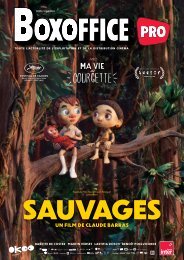Boxoffice-March.1988
You also want an ePaper? Increase the reach of your titles
YUMPU automatically turns print PDFs into web optimized ePapers that Google loves.
Modern Theatre<br />
Can 16mm Help the<br />
Small Theatreowner?<br />
The next big thing in exhibit imi<br />
may be something much smaller<br />
than we're used to seeing in theatres.<br />
EXHIBITION — AS in most industries<br />
IN— better usually means bigger: bigger<br />
screens, wider print stocks, grander<br />
sound design. But one of the more<br />
interesting technological experiments<br />
scheduled to take place this year takes a<br />
defmite turn in the opposite direction.<br />
toward small.<br />
The idea is not new but it has been,<br />
now, seemingly impossible to<br />
For<br />
up until<br />
achieve: theatre-quality 16mm film.<br />
years, distributors have been all too<br />
aware of the sometimes crippling costs<br />
of processing 35mm and 70mm prints,<br />
while exhibitors have faced the increasing<br />
expenses of shipping prints from<br />
exchange to theatre and back again. It<br />
never took a financial wizard to see that<br />
16mm, both smaller in size and lighter<br />
in weight, would drastically cut costs in<br />
both lab work and in transportation.<br />
The problem with 16mm has been<br />
one of image size: the image projected<br />
by a conventional 16mm projector becomes<br />
completely unsatisfactory on a<br />
screen any larger than what you would<br />
find in a lecture hall, a school classroom<br />
or a church basement. The idea of presenting<br />
multi-million dollar feature<br />
films on such an inferior system, and<br />
then trying to charge money from an<br />
increasingly -sophisticated public,<br />
seemed impossible.<br />
Enter Kenneth Richter, a well-known<br />
lecturer and producer of travel films.<br />
For decades, Richter had been presenting<br />
high-quality 16mm films on<br />
screens as wide as 30 feet, utilizing a<br />
little-known projector that was designed<br />
and then abandoned way bark in<br />
the '60s: the Eastman Mwlel 2.S Over 20<br />
years ago, Eastman Kodak had made a<br />
major commitment to theatre-quality<br />
16mm by designing the Mmiel 25, a<br />
remarkably sturdy projector with ,sli;rco<br />
capabilities and a relatively jjggle-frce<br />
transport system. Unfortunately, it<br />
By Tom Matthews<br />
Managing Editor<br />
turned out that no lab was willing or<br />
able to come up with an equally-precise<br />
16mm printing method. The project was<br />
abandoned, and the Model 25 was consigned<br />
to use on college campuses and<br />
in other non-theatrical applications,<br />
such as Richter's.<br />
TTie story might end there, if it<br />
weren't for a fortuitous coincidence.<br />
While at a Harvard class reunion a few<br />
years back, Richter bumped into Stanley<br />
Durwood, a former classmate who is<br />
now chairman and CEO of AMC Entertainment.<br />
Inc Curiously enough, AMC<br />
had been doing expenments of us own<br />
with 16mm, trying to find some way to<br />
work the more economical system into<br />
its rapidly-growing chain of theatres. As<br />
Durwood tells it, his engineers were<br />
simply unable to achieve a projected<br />
image that would not fall apart on a<br />
screen that was wider than 20 feet.<br />
When Durwofxi hi^ard Richter say that<br />
he was getting a clear, sharp 30-footwide<br />
image with the Eastman Model 25,<br />
Durwood was intngued. In most of the<br />
multiplexes that AMC was building, a<br />
30-foot screen was the norm.<br />
The two men put their heads together<br />
and came up with Project HQ, an ambitious<br />
enterprise that brought together<br />
experts from all areas of theatrical presentation<br />
to conquer the 16mm challenge<br />
once and for all. Charles Swing,<br />
who had developed the ELastman Model<br />
25, was lured out of retirement to consult<br />
on the project. A number of processing<br />
labs were conferred with to ultimately<br />
come up with a new 16mm print<br />
that contains over 100 lines of information<br />
per frame, a vast improvement over<br />
conventional 16mm.<br />
From Kintek Inc., Project HQ was given<br />
a customized, four track optical system<br />
that delivers a "punch" that is<br />
remarkably similar to that of 35mm's.<br />
Christie Electric designed a sjjecial xenon<br />
light source that uses a quartz negative<br />
lens to increase the f-number of its<br />
light<br />
Thf >a«lrTMn Model 2S projcdor<br />
cone, while Isco Optik GMBH of<br />
Gottingen, West Germany, manufac-<br />
March. l'»H« 19

















